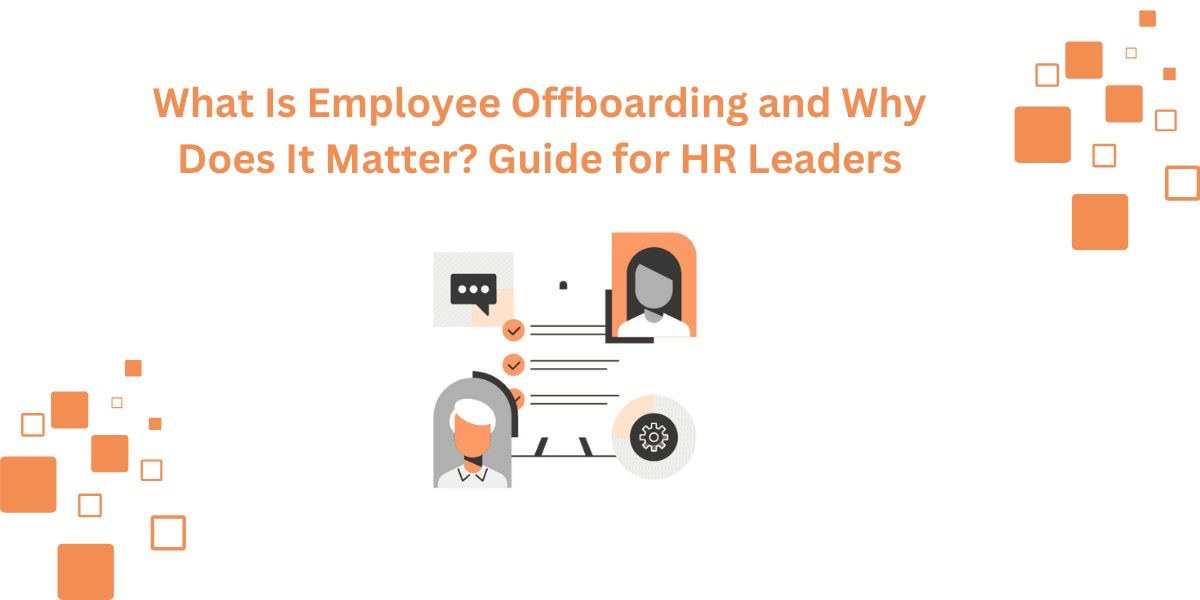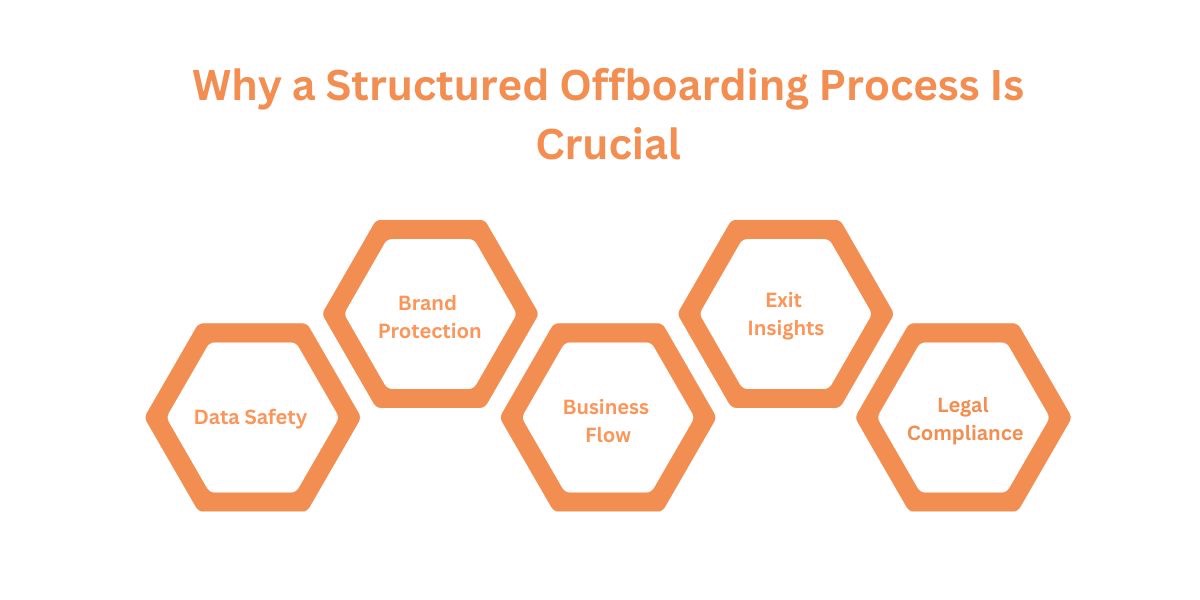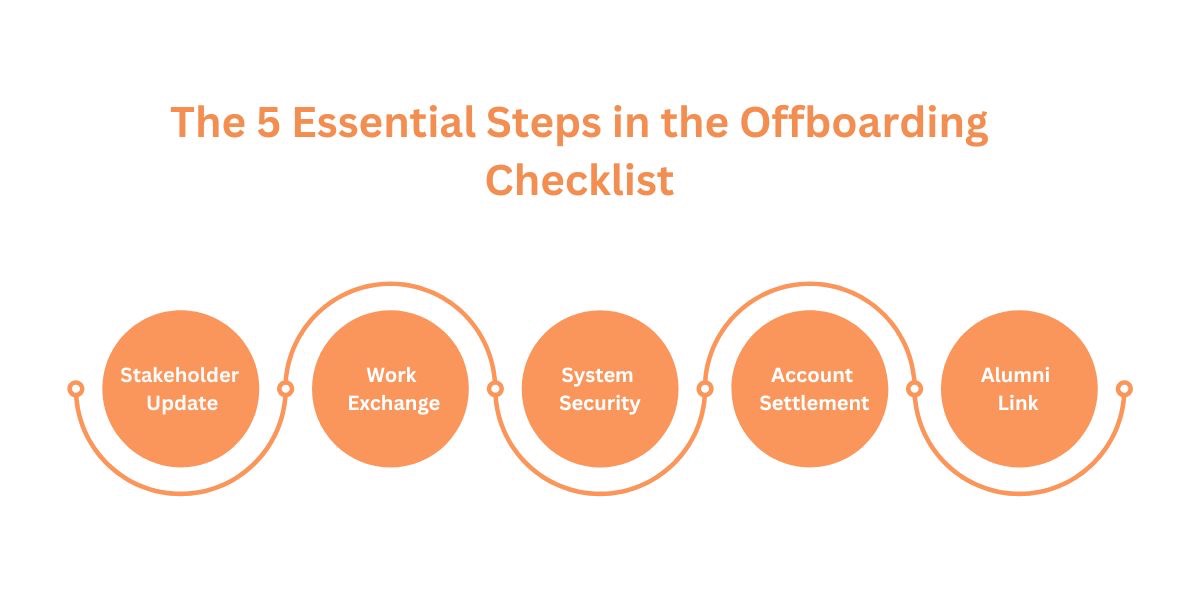What Is an HRIS (Human Resource Information System)?
Learn what an HRIS is, how it works, and why it matters. Discover its key features, benefits, and how it transforms HR operations for better efficiency.

Did you know that just 29 percent of companies have a formal process for people leaving (offboarding), but that 58 percent have a massive process for bringing people on (onboarding)? This is a significant risk caused by this gap. It is a security weak spot, a danger to your name, and a ticking bomb for business continuity (BC).
The official set of steps followed by your firm whenever an employee leaves is known as employee offboarding. It is not only about getting back a laptop. It is a careful method that secures your future. The process will be made clear in this article.
We will show its great importance in technical terms. Lastly, we will provide you with a simple plan for a smooth, legal, and good exit of employees. Offboarding is not optional. It is key to your security, business continuity (BC), and, above all, your brand as an employer. Now, let us explore the reason this is important to your human resources (HR) strategy.

Letting go encompasses all the processes involved when an employee leaves, whether by resignation, retirement, or termination. It requires collaboration between Human Resources (HR), Information Technology (IT), Legal, and Finance to ensure a rule-following, respectful, and well-planned exit.
The offboarding of an employee is the process of exiting an employee in a planned and multi-team manner. This applies whether such departure is voluntary (resignation, retirement) or involuntary (termination, layoff). It ensures that all the administrative, legal, financial, and technical tasks are completed promptly and courteously. This is a process that involves a lot of people.
Human resources (HR) owns the organization. Information technology (IT) handles security. Legal reviews documents. Finance manages final pay. Handing over knowledge is driven by the direct manager. The latter process is known as offboarding.
The onboarding is concerned with the start of an employee and giving access to and tools. Offboarding manages their exit, retrieves tools, and immediately removes access.
You are taking risks when you deal on an unplanned or "winged" basis with an exit. An unstructured process is an admin mess just waiting to happen. It may very easily lead to missing legal procedures or financial mistakes. More importantly, a bad experience of leaving may cover up years of good employment in seconds. These last days are a lasting memory.
A quick, messy, or cold exit tells a former employee that he is no longer important. This is an unfavorable feeling that they leave behind, and it is the story they tell everyone.
Quickly or suddenly letting go can cause administrative mistakes, legal trouble, and bad feelings. The bad exit experience may ruin years of good work and damage the company's good name.
You may be wondering, why spend all your time and energy on someone who is leaving? The reason is very simple: it affects your future. An organized process of offboarding is a necessary smart tool.
The first reason why offboarding should be made formal now is security. The threat is real. It is not only unhappy employees but also simple mistakes that pose a huge threat. In case the system passwords of a former employee are still active, your proprietary data is at risk. Take a look at this shocking fact: 76 percent of IT leaders regard offboarding as a big security risk.
Worse still, almost a fifth of the businesses have recorded a data breach because of a former employee. You should focus on the need for fast, written access removal. That implies an absolute digital kill switch of software as a service (SaaS) tools, email, and internal drives. Getting back all company property is also required of you.
The exit experience will surely determine what a person says after leaving your company. Consider sites such as Glassdoor, LinkedIn, and even social media. It is the story that they will tell about the last interaction. An effective offboarding process will turn former employees into long-term brand fans and advocates who refer others. Even they could turn out to be future boomerang employees.
Statistics indicate that even 62 percent of those leaving the company would consider returning if offboarding is handled positively. On the other hand, a quick or impersonal departure will result in damaging online reviews. The bad feedback will have a direct effect on your future recruiting.
Ensure a smooth, respectful, and compliant exit process with Lanteria. Our platform helps HR teams manage offboarding efficiently—protecting knowledge, maintaining compliance, and leaving a positive final impression.
Lack of process leads to operational chaos and loss of knowledge. When an employee walks out the door, they leave years of company knowledge behind. This creates great strain on the rest of the team. The most important thing that you need to do is to focus on knowledge transfer. This involves writing down important processes, contacts, and logins, and all project status reports.
You must have an organized handover period between the outgoing employee and their successor. This helps avoid knowledge gaps and helps in smooth operations.
Treat the exit interview as an important feedback tool. This is where the best information is. Leaving employees tend to be more honest than current employees. They can highlight some system-wide problems that the current workforce may be too afraid to report. Consider poor management, lack of growth, or culture issues.
Statistics indicate that a significant majority, or rather 98 percent, of employees believe that the feedback they provide during an exit interview is helpful to the company. You have to make the exit interview standard. This will allow you to gather useful, comparable information. This information is your best way to improve retention.
The only way out of legal problems is to have a formal offboarding checklist. It ensures that no admin tasks are performed improperly. This involves setting up the final payroll and paying the built-up paid time off (PTO).
It also covers the continuation of benefits (such as Consolidated Omnibus Budget Reconciliation Act (COBRA)) and signed legal documents (non-disclosure agreements (NDAs), non-competes). Proper paperwork is essential. It will stop future legal arguments and ensure that all rules are followed.

An organized letting-go plan benefits all departments by enhancing data protection, rules, brand building, and operational stability. Weak processes create security weak spots and loss of good name.
Subscribe to our newsletter for actionable strategies on managing offboarding with empathy, structure, and legal confidence—plus tips to protect your company culture and reputation.
The process of letting go consists of five necessary components: informing stakeholders, transferring knowledge, securing Information Technology (IT) resources, finalizing Human Resources (HR) and finance, and developing a good sendoff. The steps are checking for consistency and checking for rules.
First, the departure and the final day of employment should be officially acknowledged. Then, it is time to tell every party involved within the organization. These are the human resources (HR), information technology (IT), Finance, the Manager, and the team in general.
Lastly, create a professional communication plan. This covers internal announcements and, if necessary, to clients or vendors.
This step helps ensure business continuity (BC). The exiting employee is expected to make a full "Handover Document." They must save all their project files and important client information. Where possible, a well-organized shadowing or training time with their replacement, or the rest of the team, should be scheduled.
This is a security rule. Gather all the assets of the company together. These include the laptop, business telephone, and key cards. More importantly, all accounts and credentials were shut off at once (The "Digital Kill Switch"). Do not delay this step. Another precaution is to ensure that all shared passwords are changed, which is also a security measure.
The final paycheck and benefits paperwork should be completed by human resources (HR) in line with all state and federal laws. Provide all the required legal papers, which must be signed. Lastly, update the employee's status in the human resources information system (HRIS) as accurately and as timely as possible.
Carry out a fair and standard exit interview. Give a professional, respectful goodbye, be it a small team lunch or a formal announcement. The last thing is key in employer branding: ask former employees to join your company's alumni network, if it exists, to maintain a positive long-term relationship.

Letting go is sped up and made standard through automation. Departmental collaboration, error reduction, and prompt removal of access rights are some of the features of tools like Lanteria Human Resources (HR) that enhance security and enforce rules.
The main problem is obvious: offboarding through a manual process is inherently slow and full of mistakes. It is also an enormous waste of the limited human resources (HR) team. It is here that modern human resources (HR) automation offers a strong solution. Immediate sameness is started by offboarding software.
All individual employee exits undergo the same process, which follows the rules and is complete. The speed and unmatched fastness are provided by automation. Triggers can be automated to inform information technology (IT), Finance, and human resources (HR) simultaneously. This ensures that important activities, such as access revocation, happen immediately as expected.
You can configure a built-in system, such as Lanteria human resources (HR), in order to set up unique offboarding processes. This will ensure that all your special security and compliance requirements are easily fulfilled.
Letting go of employees is a structured process for handling an employee exit, including security, rules, and knowledge transfer. Unlike hiring people, the main focus of most firms is not on data security, which poses significant risks and damages their reputation.
A letting-go program is also a formal safety net that helps protect a business’s continuity, its legal structure, and the image that former employees want to project about your company. Some of the steps involve informing stakeholders, asset transfer, knowledge transfer, completing payroll, and alumni relationships.
Letting people go can be done automatically with the help of Human Resources (HR) systems such as Lanteria to save on time, avoid errors, and boost your employer brand. Simply stated, both the manner of your separation and the manner of your warm welcome to new hires determine whether your organization is successful or not.
As a Human Resources (HR) smart action, letting go leads to stronger security, moving forward, and maintaining a good brand name. To reduce the gap between the letting go and the bringing on process, companies are required to use automated, rule-following, and steady systems.
We should be clear about it: offboarding is not a small job in human resources (HR). It is a key plan. It has a direct influence on your data security, protects your valuable reputation, and ensures business continuity (BC). Your manner of parting is as important as your manner of greeting. You must end the professional relationship properly, with honor, and in accordance with the rules.
It is high time to close the onboarding and offboarding investment gap. Stop relying on manual checklists, which are full of mistakes. Invest in a human resources (HR) system that can automate and simplify these vital final steps.
Review your current process today, formalize your offboarding strategy, and ensure your final impression is as strong as your first. Book a demo to see how human resources (HR) automation can safeguard your assets and elevate your employer brand.
Offboarding, in full, is the entire documented process used when an employee is leaving the company. Termination is simply one of the reasons for departure. Offboarding includes all forms of exit, which are compliance, information security, and a transition that is easy for both the employee and the organization.
Failure of the offboarding process may lead to serious security risks if system access is not revoked. Human resources (HR) automated software helps with the immediate removal of access, securing sensitive information, and following the laws of data protection. Successful offboarding will stop breaches and ensure that company assets cannot be misused or compromised.
The time taken during offboarding will vary depending on the exit notice and cause. Access is removed on the final working day, while exit interviews and documentation occur during the notice period. It remains concerned with being thorough, compliant, and the speed of the process.
Human resources (HR) manages the entire offboarding procedure, focusing on compliance and coordination. The passing on of knowledge is handled by managers, information technology (IT) system access and equipment, and the Finance department for final pay. Centralized human resources (HR) software is used to ensure effective teamwork and the proper completion of processes step by step.
Yes, it can. A good offboarding procedure improves the employer's image. The outgoing employees can speak well of the organization, leave good reviews, and suggest job seekers. This improves the organization's image, attracts better talent, and encourages rehiring, which boosts the success of future recruiting efforts.
Schedule a demo today to see how Lanteria can help you nail every exit.
Take a product tour and explore how Lanteria’s offboarding tools help you manage documentation, recover assets, and close out employee journeys with ease and professionalism.










